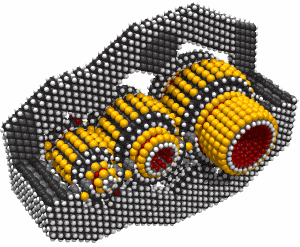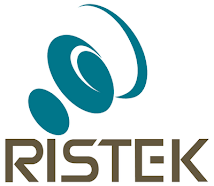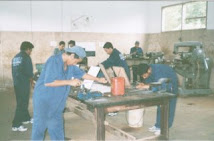Sabtu, 03 April 2010
Pendidikan Nanoteknologi
Education Center
Nanotechnology is a multidisciplinary field of discovery. Scientists working in physics, chemistry, biology, engineering, information technology, metrology, and other fields are contributing to today's research breakthroughs.
- The worldwide workforce necessary to support the field of nanotechnology is estimated at 2 million by 2015. How does the U.S. educational system train these workers and how do students choose the appropriate educational path for their interests?
- As in other fields, a passion for science is developed while students are young and an introduction to the many facets of nanotechnology will provide the basis for future educational opportunities.
- Curricula development is beginning and is available for K-12 and undergraduate education. Right now, however, only few degree programs in the field are available nationwide (and worldwide).
Dr. Robert Chang on Teaching and Learning Nanotechnology
 Robert P.H. Chang, director of the National Center for Learning and Teaching (NCLT), explains the goals and challenges facing education in the field of nanotechnology in an interview with NNCO. Dr. Chang is a professor of materials science and engineering at Northwestern University.
Robert P.H. Chang, director of the National Center for Learning and Teaching (NCLT), explains the goals and challenges facing education in the field of nanotechnology in an interview with NNCO. Dr. Chang is a professor of materials science and engineering at Northwestern University.
Nano Teaching Resources Available at NanoEd.org
 Teachers looking for help with nanoscience and technology curriculum can find assistance on the NanoEd Resource Portal. NanoEd is a "one-click resource" site for finding educational resources and to showcase work to facilitate collaborations within the Nanoscale Science and Engineering Education (NSEE) community.
Teachers looking for help with nanoscience and technology curriculum can find assistance on the NanoEd Resource Portal. NanoEd is a "one-click resource" site for finding educational resources and to showcase work to facilitate collaborations within the Nanoscale Science and Engineering Education (NSEE) community.
The site, sponsored by the National Center for Learning and Teaching in Nanoscale Science and Engineering (NCLT), offers educational resources to help teachers with nanotechnology-related concepts, simulations, and activities for the classroom.
- Educational materials for science teachers and students in grades 7-12, college and university students and faculty, researchers, and post doc students, covering information on Nano Courses & Units in engineering, physics, materials science, chemistry, and education.
- Seminars to advance education initiatives.
- Learning Research and Methods, a collection of papers, presentations and resources to promote the best teaching practices and methodologies.
- Nanoconcepts and Applications, instructional materials focusing on the key ideas in nanoscale science and engineering.
- NSEE Resources and Calendar of Events for nanoscale science and engineering education.
- NSEE News and Network and a Glossary.
NCLT, funded by the National Science Foundation, was established in October 2004 to build national capacity in nanoscale science and engineering education. Housed at Northwestern University, NCLT collaborates with scientists at the following research institutions: University of Michigan, Purdue University, University of Illinois at Chicago, University of Illinois at Urbana-Champaign, Argonne National Laboratory, Alabama A&M University, Fisk University, Hampton University, Morehouse College, and University of Texas at El Paso.
NISE Network
The Nanoscale Informal Science Education (NISE) Network brings researchers and informal science educators together to inform the public about nanoscience and technology. Now, through a new Web site, nisenet.org, you can access a vast collection of educational resources and even join in this creative community effort.
For teachers, students, or anyone interested in nanoscience and the many potential nanotechnology applications, the Web site's content includes study materials, academic approaches, collections of graphics, a newsletter, links to other institutions working in the field, and much more.
The NISE Network consists of the Museum of Science, Boston, the Exploratorium in San Francisco, the Science Museum of Minnesota and a growing group of partners and advisors. With a five-year, $20 million grant from the National Science Foundation, the NISE Network is working to bring the education and research communities together in an effort to
- create new methods and approaches to communicate the work of nanoscale scientists and engineers
- inform the public about the advances in the scientific research, and
- capture the imagination of youth who may choose careers in nanoscale science and engineering.
Read more about the projects of the NISE Network.
When Things Get Small
 What could a stadium-size bowl of peanuts, a shrinking elephant and a crazed hockey player have to do with nanoscience? Those are just some of the goofy excursions that await you when witty host Adam Smith and wacky physicist Ivan Schuller take you on an irreverent, madcap, comically corny romp into the real-life quest to create the smallest magnet ever known. "When Things Get Small" was funded by the National Science Foundation, and produced by UCSD-TV in partnership with the California Institute for Telecommunications and Information Technology (Calit2).
What could a stadium-size bowl of peanuts, a shrinking elephant and a crazed hockey player have to do with nanoscience? Those are just some of the goofy excursions that await you when witty host Adam Smith and wacky physicist Ivan Schuller take you on an irreverent, madcap, comically corny romp into the real-life quest to create the smallest magnet ever known. "When Things Get Small" was funded by the National Science Foundation, and produced by UCSD-TV in partnership with the California Institute for Telecommunications and Information Technology (Calit2).
See When Things Get Small (Nano fun on TV)
 A five-year goal of the NNI is to ensure that 50% of US research institutions' faculty and students have access to the full range of nanoscale research facilities, and student access to education in nanoscale science and engineering is enabled in at least 25% of the research universities.
A five-year goal of the NNI is to ensure that 50% of US research institutions' faculty and students have access to the full range of nanoscale research facilities, and student access to education in nanoscale science and engineering is enabled in at least 25% of the research universities.
Mihail C. Roco, NSF Senior Advisor for Nanotechnology.
Pendidikan Nanoteknologi

 I want people who are very deep in their discipline and can talk to each other.
I want people who are very deep in their discipline and can talk to each other.
Stan Williams, Director, Quantum Science Research, Hewlett Packard
Highly regarded researcher Stan Williams says that students often ask him what they should study to prepare for the field of nanotechnology. "I tell them to figure out what they like and get good at it and to take communications courses, whether writing or journalism," he notes. While nanotechnology is an interdisciplinary and multidisciplinary field, Williams is concerned that students could pursue too broad an education and end up knowing a little about a lot of fields, but not enough in any one field to make significant contributions.
There are undoubtedly other opinions about education in nanotechnology, and it's a subject worthy of consideration as students plan their studies. Today, few universities offer degrees in nanotechnology, although a vast number of research universities offer courses in the field. Many universities also offer undergraduate experiences in interdisplinary centers.
Degrees in Nanotechnology
In conjunction with the University of Pennsylvania, an Associate Degree in Nanobiotechnology is now offered at community colleges in Pennsylvania.
Dakota County Technical College (Rosemount, Minn.) in conjunction with the University of Minnesota, Associate in Applied Science degree in Nanoscience Technology
City University of New York offers a Ph.D. in Nanotechnology & Materials Chemistry as part of the Ph.D. program in chemistry.
Louisiana Tech University offers a Bachelor of Science in Nanosystems Engineering, a Master of Science in Molecular Sciences and Nanotechnology, and an interdisciplinary Ph.D. in Engineering that focuses on micro/nanosystems.
Rice University offers a Professional Master of Science in Nanoscale Physics
University at Albany College of Nanoscale Science and Engineering (CNSE), offers a Ph.D. and a MS in both Nanoscale Science and Nanoscale Engineering. It also offers two dual-degree "Nano+MBA" programs: MS in Nanoscale Science/Masters of Business Administration and MS in Nanoscale Engineering/Masters of Business Administration.
University of North Carolina at Charlotte, Ph.D. Program in Nanoscale Science
University of Washington, Ph.D. in Nanotechnology
North Seattle Community College offers an Associate of Applied Science-T degree in nanotechnology, soon to be joined by a certificate program.
Examples of Programs and Courses on Nanoscale Science and Engineering Offered in U.S. Colleges and Universities
Cornell University, Nanobiotechnology Course
Florida Institute of Technology, Nanoscience/Nanotechnology Lab Course
George Mason University, Graduate Certificate in Nanotechnology and Nanoscience
Kansas State University, Visual Quantum Mechanics
Michigan Technological University, interdisciplinary minor in Nanoscale Science and Engineering (Nanotechnology)
Normandale Community College, Associate in Applied Science Degree in Nanotechnology with emphasis in vacuum technology and surface science or semiconductor process technician.
Penn State University, Center for Nanotechnology Education and Utilization, Nanofabrication Manufacturing Technology (NMT) Capstone Semester, for two-year colleges
Purdue University, Graduate Level Courses in Nanoscale Science and Engineering
Rensselaer Polytechnic Institute, Nanostructured Materials
Rice University, Introduction to Nanoscience
University of Central Florida, Nanoscience and Nanotechnology Track (B.S.) Liberal Studies Major
University of Maryland, Nano-related Courses at UMD
University of Texas at Austin's Doctoral Portfolio Program in Nanotechnology is a certification program which provides a formal mechanism for recognizing and rewarding students who obtain the broad educational background necessary to become leaders in nanotechnology after graduation.
University of Washington, and Pacific Northwest National Laboratory, the Joint Institute for Nanoscience and Nanotechnology, Intensive Courses in Nanoscience and Nanotechnology
University of Wisconsin - Madison and other institutions collaborating with the UW Materials Research Science and Engineering Center on Nanostructured Interfaces, Nano-related Course Information and Syllabi
University of Wisconsin - Stout offers a Bachelor of Science in Applied Science with Nanoscience Concentration and Bachelor of Science in Engineering Technology with a Concentration in Nanotechnology. UW-Stout also offers four undergraduate courses in Nanoscience/Nanotechnology.
Other Resources:
Every summer, the National Nanofabrication Infrastructure Network hosts a Research Experience for Undergraduates Program (NNIN REU) from June to August. Engineering and science students with a genuine interest in nanotechnology are eligible if they are not graduating before the end of the program in August. Also, applicants must be Citizens or Permanent Residents of the United States. Minority and female candidates are especially encouraged to apply. For the full program information, please visit the NNIN REU Information Center.
Cornell University, Research Experience for Undergraduates at the Nanobiotechnology Center
Northwestern University, Research Experience for Undergraduates at the Nanoscale Science and Engineering Center
University of Central Florida, Research Experience for Undergraduates at the Nanoscience and Technology Center
University of North Carolina at Charlotte, NanoSURE Undergraduate Research Program
See also
Careers in Nanotechnology, Scholarships, Fellowships, & Postdoctoral Positions
Nanoteknologi
What is Nanotechnology?
| A basic definition: Nanotechnology is the engineering of functional systems at the molecular scale. This covers both current work and concepts that are more advanced. In its original sense, 'nanotechnology' refers to the projected ability to construct items from the bottom up, using techniques and tools being developed today to make complete, high performance products. | With 15,342 atoms, this parallel-shaft speed reducer gear is one of the largest nanomechanical devices ever modeled in atomic detail. LINK |
 The Meaning of Nanotechnology
The Meaning of Nanotechnology
When K. Eric Drexler (right) popularized the word 'nanotechnology' in the 1980's, he was talking about building machines on the scale of molecules, a few nanometers wide—motors, robot arms, and even whole computers, far smaller than a cell. Drexler spent the next ten years describing and analyzing these incredible devices, and responding to accusations of science fiction. Meanwhile, mundane technology was developing the ability to build simple structures on a molecular scale. As nanotechnology became an accepted concept, the meaning of the word shifted to encompass the simpler kinds of nanometer-scale technology. The U.S. National Nanotechnology Initiative was created to fund this kind of nanotech: their definition includes anything smaller than 100 nanometers with novel properties.
Much of the work being done today that carries the name 'nanotechnology' is not nanotechnology in the original meaning of the word. Nanotechnology, in its traditional sense, means building things from the bottom up, with atomic precision. This theoretical capability was envisioned as early as 1959 by the renowned physicist Richard Feynman.
I want to build a billion tiny factories, models of each other, which are manufacturing simultaneously. . . The principles of physics, as far as I can see, do not speak against the possibility of maneuvering things atom by atom. It is not an attempt to violate any laws; it is something, in principle, that can be done; but in practice, it has not been done because we are too big. — Richard Feynman, Nobel Prize winner in physics
Based on Feynman's vision of miniature factories using nanomachines to build complex products, advanced nanotechnology (sometimes referred to as molecular manufacturing) will make use of positionally-controlled mechanochemistry guided by molecular machine systems. Formulating a roadmap for development of this kind of nanotechnology is now an objective of a broadly based technology roadmap project led by Battelle (the manager of several U.S. National Laboratories) and the Foresight Nanotech Institute.
Shortly after this envisioned molecular machinery is created, it will result in a manufacturing revolution, probably causing severe disruption. It also has serious economic, social, environmental, and military implications.
Four Generations
Mihail (Mike) Roco of the U.S. National Nanotechnology Initiative has described four generations of nanotechnology development (see chart below). The current era, as Roco depicts it, is that of passive nanostructures, materials designed to perform one task. The second phase, which we are just entering, introduces active nanostructures for multitasking; for example, actuators, drug delivery devices, and sensors. The third generation is expected to begin emerging around 2010 and will feature nanosystems with thousands of interacting components. A few years after that, the first integrated nanosystems, functioning (according to Roco) much like a mammalian cell with hierarchical systems within systems, are expected to be developed.

Some experts may still insist that nanotechnology can refer to measurement or visualization at the scale of 1-100 nanometers, but a consensus seems to be forming around the idea (put forward by the NNI's Mike Roco) that control and restructuring of matter at the nanoscale is a necessary element. CRN's definition is a bit more precise than that, but as work progresses through the four generations of nanotechnology leading up to molecular nanosystems, which will include molecular manufacturing, we think it will become increasingly obvious that "engineering of functional systems at the molecular scale" is what nanotech is really all about.
Conflicting Definitions
Unfortunately, conflicting definitions of nanotechnology and blurry distinctions between significantly different fields have complicated the effort to understand the differences and develop sensible, effective policy.
The risks of today's nanoscale technologies (nanoparticle toxicity, etc.) cannot be treated the same as the risks of longer-term molecular manufacturing (economic disruption, unstable arms race, etc.). It is a mistake to put them together in one basket for policy consideration—each is important to address, but they offer different problems and will require different solutions. As used today, the term nanotechnology usually refers to a broad collection of mostly disconnected fields. Essentially, anything sufficiently small and interesting can be called nanotechnology. Much of it is harmless. For the rest, much of the harm is of familiar and limited quality. But as we will see, molecular manufacturing will bring unfamiliar risks and new classes of problems.
General-Purpose Technology
Nanotechnology is sometimes referred to as a general-purpose technology. That's because in its advanced form it will have significant impact on almost all industries and all areas of society. It will offer better built, longer lasting, cleaner, safer, and smarter products for the home, for communications, for medicine, for transportation, for agriculture, and for industry in general.
Imagine a medical device that travels through the human body to seek out and destroy small clusters of cancerous cells before they can spread. Or a box no larger than a sugar cube that contains the entire contents of the Library of Congress. Or materials much lighter than steel that possess ten times as much strength. — U.S. National Science Foundation
Like electricity or computers before it, nanotech will offer greatly improved efficiency in almost every facet of life. But as a general-purpose technology, it will be dual-use, meaning it will have many commercial uses and it also will have many military uses—making far more powerful weapons and tools of surveillance. Thus it represents not only wonderful benefits for humanity, but also grave risks.
A key understanding of nanotechnology is that it offers not just better products, but a vastly improved manufacturing process. A computer can make copies of data files—essentially as many copies as you want at little or no cost. It may be only a matter of time until the building of products becomes as cheap as the copying of files. That's the real meaning of nanotechnology, and why it is sometimes seen as "the next industrial revolution."
My own judgment is that the nanotechnology revolution has the potential to change America on a scale equal to, if not greater than, the computer revolution. — U.S. Senator Ron Wyden (D-Ore.)
The power of nanotechnology can be encapsulated in an apparently simple device called a personal nanofactory that may sit on your countertop or desktop. Packed with miniature chemical processors, computing, and robotics, it will produce a wide-range of items quickly, cleanly, and inexpensively, building products directly from blueprints.
 ◄ Click to enlarge
◄ Click to enlarge
Artist's Conception of a Personal Nanofactory
Courtesy of John Burch, Lizard Fire Studios (3D Animation, Game Development)
Exponential Proliferation
Nanotechnology not only will allow making many high-quality products at very low cost, but it will allow making new nanofactories at the same low cost and at the same rapid speed. This unique (outside of biology, that is) ability to reproduce its own means of production is why nanotech is said to be an exponential technology. It represents a manufacturing system that will be able to make more manufacturing systems—factories that can build factories—rapidly, cheaply, and cleanly. The means of production will be able to reproduce exponentially, so in just a few weeks a few nanofactories conceivably could become billions. It is a revolutionary, transformative, powerful, and potentially very dangerous—or beneficial—technology.
How soon will all this come about? Conservative estimates usually say 20 to 30 years from now, or even much later than that. However, CRN is concerned that it may occur sooner, quite possibly within the next decade. This is because of the rapid progress being made in enabling technologies, such as optics, nanolithography, mechanochemistry and 3D prototyping. If it does arrive that soon, we may not be adequately prepared, and the consequences could be severe.
We believe it's not too early to begin asking some tough questions and facing the issues:
| Who will own the technology? | |
| Will it be heavily restricted, or widely available? | |
| What will it do to the gap between rich and poor? | |
| How can dangerous weapons be controlled, and perilous arms races be prevented? |
Many of these questions were first raised over a decade ago, and have not yet been answered. If the questions are not answered with deliberation, answers will evolve independently and will take us by surprise; the surprise is likely to be unpleasant.
It is difficult to say for sure how soon this technology will mature, partly because it's possible (especially in countries that do not have open societies) that clandestine military or industrial development programs have been going on for years without our knowledge.
We cannot say with certainty that full-scale nanotechnology will not be developed with the next ten years, or even five years. It may take longer than that, but prudence—and possibly our survival—demands that we prepare now for the earliest plausible development scenario.
More Background on Nanotechnology:
| Nanotechnology Basics - For students and other learners | |
| Managing Magic - A brief overview of the challenges posed by advanced nanotechnology | |
| Nanotechnology on an Upward Slope - An online PowerPoint presentation | |
| Turn on the Nanotech High Beams - An essay published by Future Brief | |
| Nano Simulation - A way to visualize what is meant by molecular manufacturing | |
| Debating the Future of Nanotechnology - Perspective from the Foresight Institute | |
| Safe Utilization of Advanced Nanotechnology - One of the founding papers of CRN | |
| 5-Minute Nanosystems - A quick summary of Eric Drexler's foundational work on nanotechnology | |
| Nanotechnology Press Kit - Compiled and published by Nanotechnology Now |












